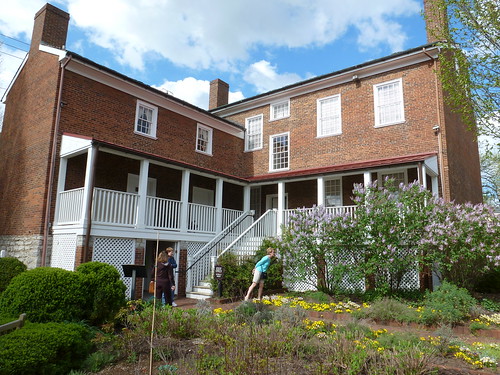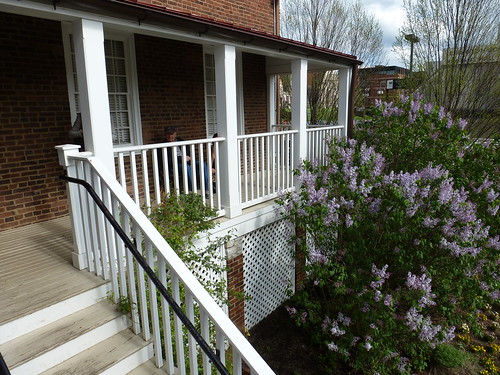Front of the Mary Todd Lincoln House, Lexington, KY
I'm currently in Lexington, KY for work, and when I discovered that this is the home of the Mary Todd Lincoln House Museum, I knew I'd have to squeeze some time into my crazy schedule to pay a visit. This afternoon, thoroughly enjoying the gorgeous spring weather and all the flowering trees, I took a walk to the museum and was fortunate enough to catch the last tour of the day. The guide was fantastic and extremely knowledgeable about the Todd and Lincoln families and the details of the house's history, and those of us on the tour were treated to an hour-plus journey through the home, accompanied by numerous juicy little tidbits of history that one rarely hears recited or discussed today (you know, those "Wow, how didn't I know that before now?" kind of tidbits!).
I wish I could include some pictures of the interior of the house because it is beautifully restored and furnished with some gorgeous antiques and Todd and Lincoln family heirlooms, but, as I'm sure you'd expect, photography was not permitted inside. Much to my immense pleasure, though, I'm very happy to report that the museum's website includes a lovely picture tour of many of the rooms, with detail shots of some of the special items in them.
Mary Todd was born in Lexington in 1818, in a house several blocks away from the current museum (that house no longer stands). In 1832, the growing Todd family (there would eventually be 16 total children, with 14 who survived into adulthood) moved to the c.1803-5 brick house that is now the Mary Todd Lincoln House. She lived there until 1842, when she moved to Springfield, Illinois to live with her elder sister and her family. It was there, of course, that she met and married Abraham Lincoln, and the couple is known to have visited and stayed in this Lexington home several times during the early years of their marriage. Mary’s father, Robert Todd, died in 1849 and the house and the entirely of its contents were sold at auction. A couple of those original family items have been donated back to the museum in recent years, but the majority of the furniture and other decorative items on display are antiques acquired to mirror those found listed in an inventory taken at Robert Todd's death.
As Kentucky was a border state during the Civil War, it did not surprise me to learn that the Todd family was the quintessential “house divided,” with exactly half of them supporting the Confederacy, while the other half remained staunchly loyal to the Union. Four of the Todd brothers fought for the Confederacy; two of them died in that service. For this reason, Mary was looked upon with great suspicion by both sides throughout the war, with Union supporters worried the President’s wife harbored Southern sympathies, and the Confederates convinced she was a Union spy.
The back of the house, from the garden.
One of the most interesting things our guide shared today was an account of Mary’s very early exposure to the issue of slavery. Throughout Mary’s childhood and into her adulthood, the Todd family owned between three and five slaves. Her step-grandmother (Robert Todd married a second time after Mary’s mother died in childbirth) also owned slaves and had a very decided opinion on slavery as both a moral and a socio-cultural issue. At her death, she elected to set her slaves free, and Mary’s respect for her would certainly have influenced her own thoughts on that choice. The very well-educated Mary (who had a keen interest in politics from an early age and whose father would permit her to sit in and listen to the gentlemen’s after-dinner political conversations) would thus undoubtedly have been exposed to discussions about emancipation vs. abolition and the complexities of the institution of slavery, and been able to develop her own educated convictions on the subject before she even met her future “Great Emancipator” husband.
The back porch.
Our guide spoke a bit about Mary’s keen sense of fashion and how much she enjoyed showing off her shoulders, even after the ripe “old” age of forty (much to the scandal of Washington!). She employed a personal seamstress to make her clothes when she moved into the White House, and her expensive, fashionable tastes were yet another source of controversy for the Lincoln family during the War years. I inquired whether any of the Mary’s clothes had survived, and was shown a delightful little watch, a mourning bonnet, a mourning fan, and a pretty little black mourning jacket that are currently in the museum’s collections. The guide said that following Lincoln’s death, Mary felt obliged to sell a number of her gowns to pay outstanding debts; when she died, the remainder were dispersed amongst relatives. The Smithsonian has her stunning velvet inaugural gown in their collection (click on the image to see multiple views), but for a woman of such prominence, and who was so preoccupied with fashion, it’s strange – and really a shame – that not more of her garments or personal accessories are known to have survived to teach us more about the lady who was Mrs. Lincoln.
Many of the tragic episodes that marked Mary Todd Lincoln's life are well known, from the untimely deaths of all but one of her sons to the tragic assassination of her husband. Throughout her life, she suffered from poor heath, often plagued by migraines and depression. What I did not know was that her one surviving son, Robert, had his mother confined in a mental institution in 1875. Worried by her apparent delusional and erratic behavior, he went so far as to take the stand to testify against her in order to gain the requisite court order to have his mother committed. Though Mary was released after several months into the care of her sister, the rift that this betrayal caused between mother and son was never healed. Mary Todd Lincoln died in 1882, and remains one of the most intriguing - and controversial - of our First Ladies.





5 comments:
This post is a very nice tribute to Mary. You have a wonderful gift for writing.
I was not aware of the museums presence. I am glad you took the time to go and share it with us bloggers. Thank you.
This post is a very nice tribute to Mary. You have a wonderful gift for writing.
I was not aware of the museums presence. I am glad you took the time to go and share it with us bloggers. Thank you.
I enjoyed seeing this and the links you put in. How interesting that you found this now. They are going to retry Mrs. Lincoln according to today's medical standards. Her son Robert's home "Hildene" is one of my favorite places to visit in Manchester NH. Have you seen it?
Sorry, I mean Manchester, VT. That is where Hildene is located. Jan
Thanks, Rebecca! I'm glad you enjoyed the post. I love "discovering" little-known historic places - they're usually the best treasures of all! :-)
Jan, I had no idea about Robert's house. That's definitely going on our list of "must-sees"! Thanks for sharing that. I didn't know about the re-trial, either, so I just googled it and read some more. Very, very interesting, and I so wish I could go to see it done because I bet it will be fascinating. I'm surprised they didn't mention that during the MTL house tour, though. We talked about the painting hoax (hmm...I feel a new post coming on...!), and we talked about the original trial in good detail, but nothing about the re-trial. I'm really looking forward to seeing how that "plays" out in September.
Post a Comment